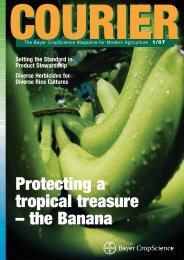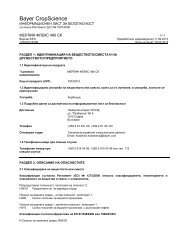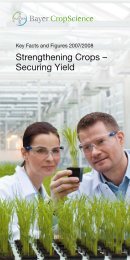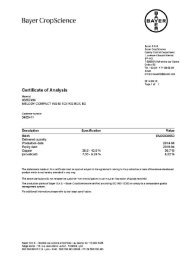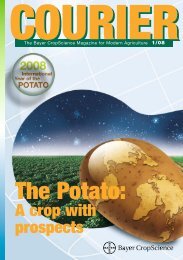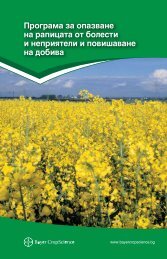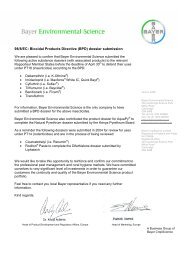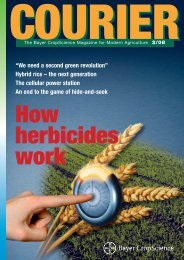For healthy potatoes - Bayer CropScience
For healthy potatoes - Bayer CropScience
For healthy potatoes - Bayer CropScience
You also want an ePaper? Increase the reach of your titles
YUMPU automatically turns print PDFs into web optimized ePapers that Google loves.
Fusarium ear blight<br />
Snow mould in<br />
winter barley<br />
In order to support this, treated seed must<br />
satisfy a number of requirements. It must<br />
have an adequate thousand-seed weight,<br />
good germinability, varietal purity and last<br />
but not least, it must be free of infection.<br />
Given the major importance of seed to<br />
the farmer, legal requirements designed to<br />
guarantee seed quality were established at<br />
an early stage. One example is the set of<br />
requirements laid down in the seed-quality<br />
regulations that determine the maximum<br />
allowable levels of infection of seed crops<br />
by various pathogens. Seed lots that satisfy<br />
these criteria are considered to be acceptable<br />
– but no information is available about<br />
exact levels of infection below these<br />
thresholds.<br />
The major problems here are those fungal<br />
diseases that are transmitted exclusively<br />
via the seed, and which can therefore<br />
only be controlled effectively through<br />
seed-treatment. These pathogens tend to<br />
have very short generation times, so they<br />
are often able to build up their populations<br />
quickly and cause extensive damage, even<br />
if infection in the original seed crop was<br />
within the thresholds set in the seed quality<br />
regulations. This is why severe infections<br />
occur regularly if seed-treatment is omitted,<br />
even if high-quality seed has been<br />
used: this results in serious losses in yield<br />
and quality, and ultimately, economic<br />
penalties. The only reliable method for<br />
avoiding this problem remains the systematic<br />
use of seed-treatments based on effective<br />
crop protection compounds.<br />
Modern active substances have<br />
a broad spectrum-of-action<br />
Following the ban, more than 25 years ago,<br />
on the marketing of mercury-based crop<br />
protectants, a whole range of new active<br />
substances and products were developed<br />
for use as seed-treatments. Some of these<br />
new compounds were the first systemic<br />
active substances; they were able to control<br />
pathogens that had previously been uncontrollable,<br />
or which were controllable only<br />
through dosages so heavy that they jeopardized<br />
the vitality and germinability of<br />
the seed. Today, a large number of different<br />
systemic seed-treatments are available on<br />
the market, which can differ greatly in<br />
their properties, as well as in price. Nor has<br />
product development stopped in this area,<br />
as is demonstrated by the ongoing adoption<br />
of active substances from the strobil-<br />
urin class into new seed-treatment products.<br />
Seed-treatments designed to control<br />
seed-borne pathogens, including the various<br />
smuts, the snow mould pathogen<br />
(Microdochium nivale), and Fusarium culmorum,<br />
must meet certain minimum standards<br />
in terms of percent control. Product<br />
efficacy against seed-borne pathogens is<br />
tested for during the biological trials that<br />
are required under the regulatory procedure.<br />
However, many systemic active substances,<br />
especially those in the triazole<br />
class, show spectra-of-action that go well<br />
beyond the official requirements, controlling<br />
a range of significant leaf-diseases<br />
too. These include the pathogens that cause<br />
mildews, net-blotch of barley, common<br />
root rot of barley and rye, Rhynchosporium,<br />
both species of Septoria, rusts,<br />
Fusaria and others. One specialist area in<br />
the use of seed-treatments is the control of<br />
take-all of cereals. This disease is not actually<br />
seed-borne, but as a „disease of rotations“,<br />
it can nevertheless only be controlled<br />
directly using the appropriate seedtreatments.<br />
There is now a choice of seed-treatment<br />
products on the market that are registered<br />
for the control of these pathogens. Some of<br />
these have certain incidental effects that<br />
can positively influence the emergence and<br />
early development of the cereal plant, i.e.<br />
beyond the active substance’s direct fungicidal<br />
effect. Although for some diseases<br />
(e.g. smuts), there is a direct correlation<br />
between the number of infected ears and<br />
the extent of harvest losses, the yield benefit<br />
associated with the use of broad-spectrum<br />
seed-treatments is not always attributable<br />
to the control of a specific pathogen.<br />
As well as differing in their spectra-ofaction,<br />
seed-treatments differ in their<br />
potency, particularly under “worst-case”<br />
conditions. Strong infection potential tends<br />
to highlight a product’s reserves, or con-<br />
Stinking smut of wheat<br />
Loose smut of barley<br />
2/06 COURIER 29





